Equipment / Instruments
Unit 11: Sutures & Other Materials
Topic 2: Needles
There are a number of ways in which a suture is constructed and described. Sutures may have a swaged needle on to which they are permanently attached. Most packaged sutures now contain swaged needles.
There are also eyed needles through which suture materials may be threaded. The eyed needles, unlike the swaged, are reusable but do cause increased tissue trauma during their passage through tissue due to their greater cross sectional area at the eye.
Threading an eyed needle
Eyed needles are threaded from inside to outside. This helps prevent the thread from falling out of the eye when the needle is lifted.
Do not double thread an eyed needle. Whilst this might stop the thread from falling out, it will greatly increase tissue trauma.
The shape of the needle also varies considerably and is normally described according to their shape, such as straight, half curved, half circle and 3/8 circle etc.
Needles are also described by their point, and are described as either being round bodied and tapered or cutting. Cutting needles are further described as being a standard cutting or a reverse cutting needle, which helps minimise the chances of the suture cutting out. Tapered needles are generally used for suturing parenchymatous and delicate tissues, whilst cutting needles are used for suturing dense resilient tissues such as skin.



